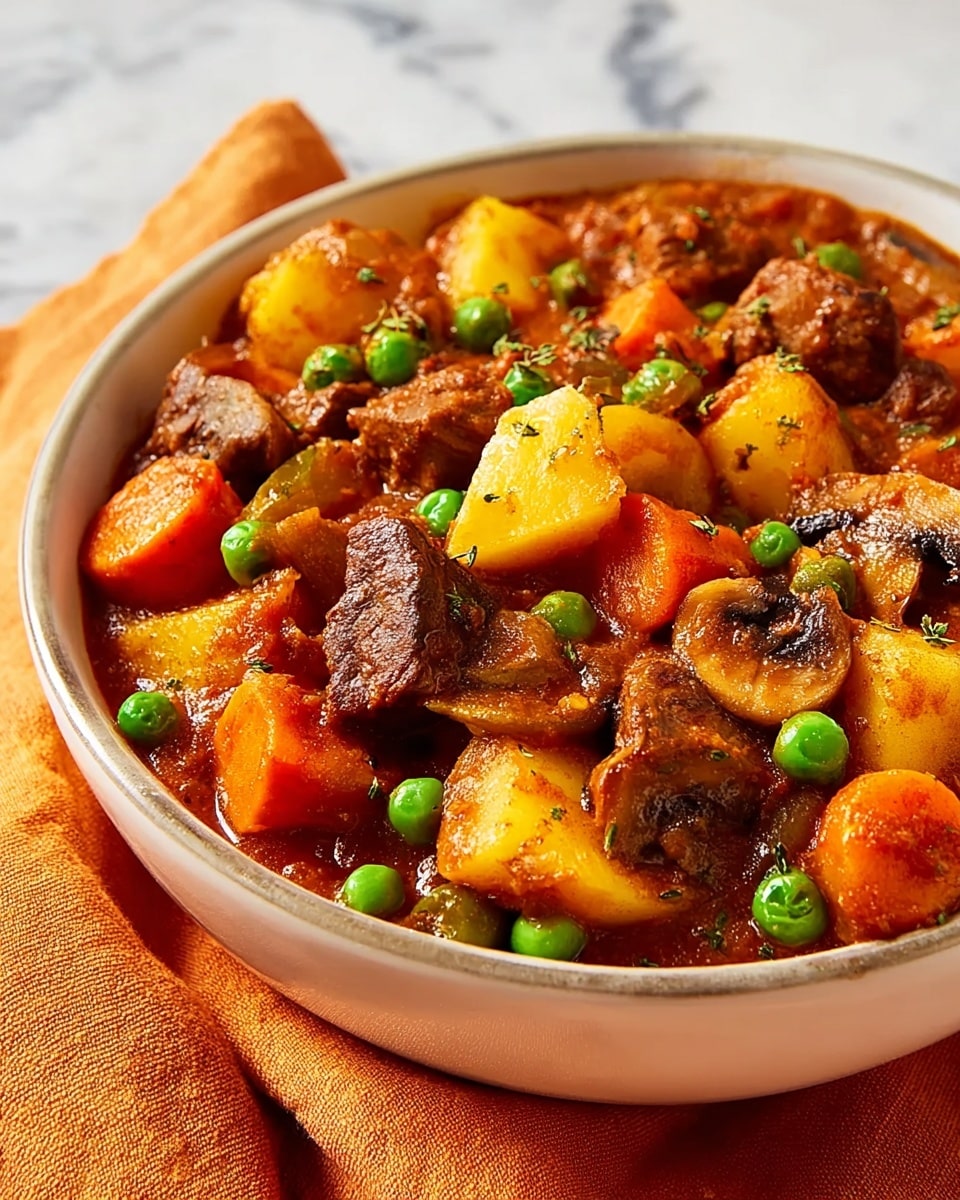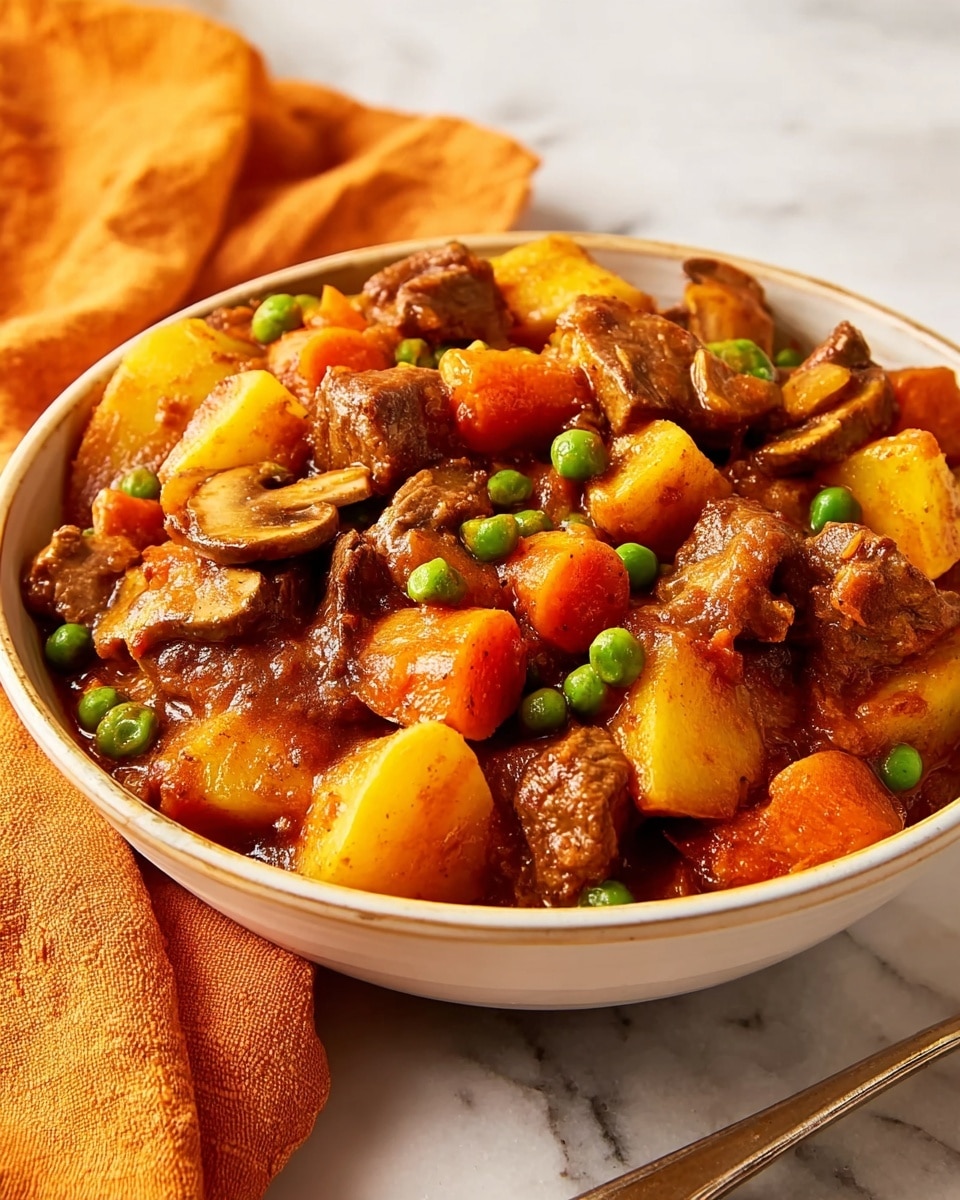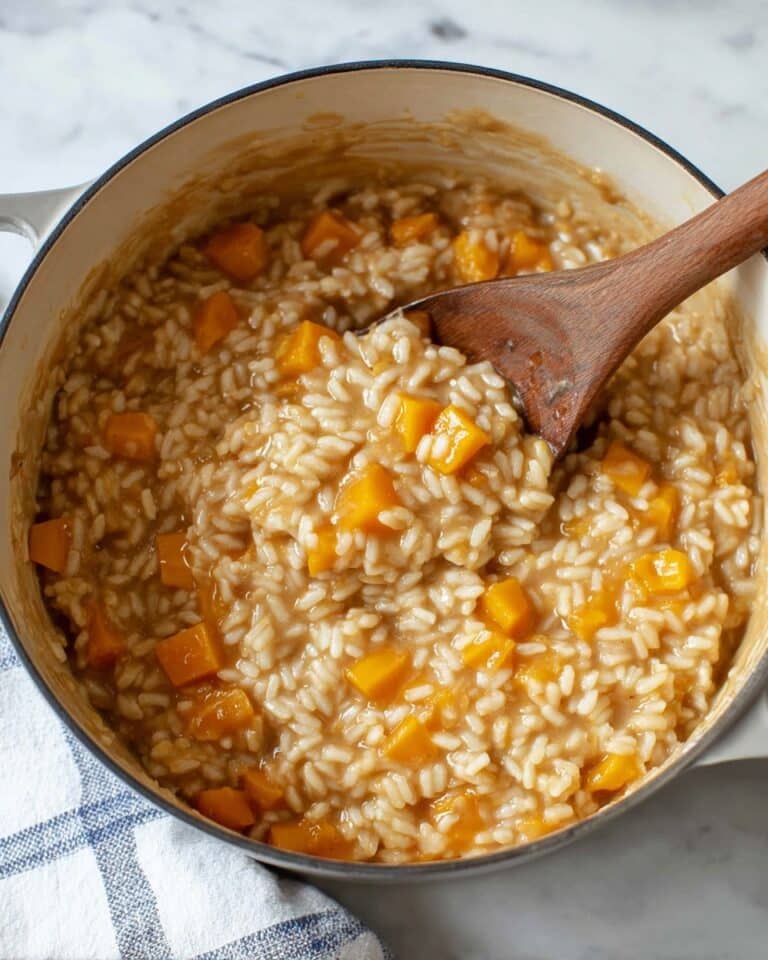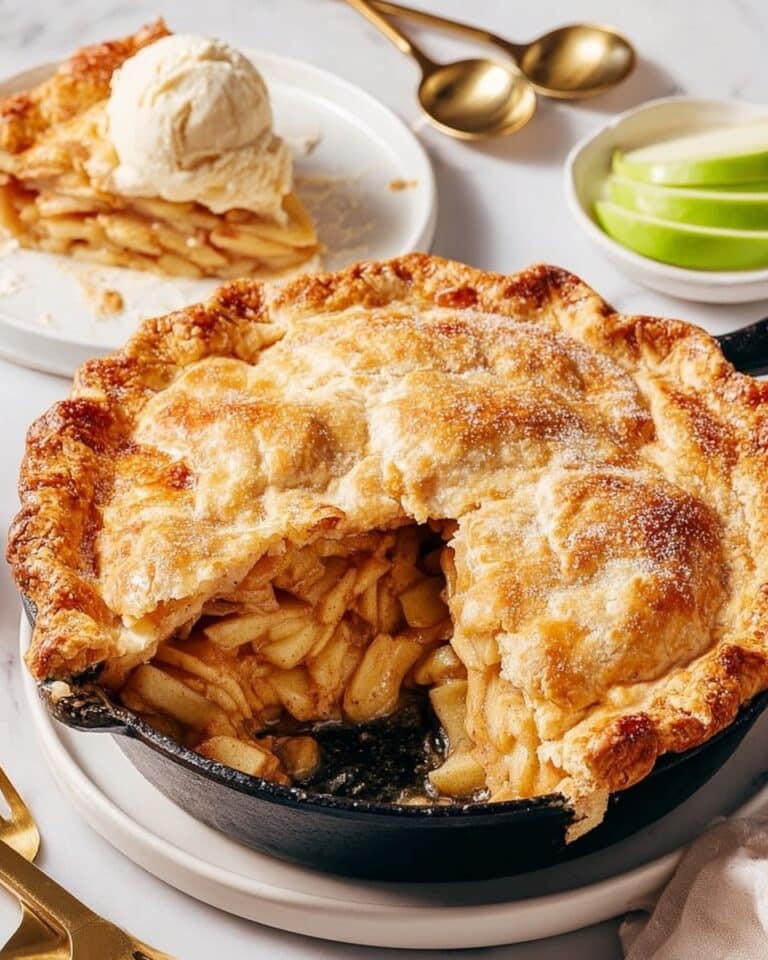If you’re craving something comforting, nourishing, and downright satisfying, you’ve gotta try this Hearty Beef and Vegetable Stew Recipe. It’s one of those recipes that warms you from the inside out, perfect for cozy evenings or when you want a meal that feels like a big hug in a bowl. I absolutely love how tender the beef turns out and how all those veggies soak up the rich, flavorful broth. Trust me, once you make this, it’ll become a go-to in your kitchen too.
Why You’ll Love This Recipe
- Rich, Deep Flavor: The tomato paste and herbs build layers of savory goodness you’ll savor in every bite.
- Perfectly Tender Meat: Slow simmering makes the beef melt-in-your-mouth soft without losing any juiciness.
- Nutrient-Packed Veggies: Potatoes, carrots, mushrooms, and peas keep it colorful and hearty while adding great texture.
- Crowd-Pleaser: I’ve never met anyone who didn’t ask for seconds—your family will thank you!
Ingredients You’ll Need
Each ingredient in this stew works together to create a comforting, well-rounded meal. Make sure to pick fresh vegetables and good quality stew meat—the flavor you get from fresh, quality ingredients really shines here.
- Vegetable Oil: I like using a neutral vegetable oil so it doesn’t compete with the beef’s rich flavor.
- Beef Stew Meat: Look for well-marbled beef cubes—they become so tender after slow cooking.
- Onion: Thinly sliced for that subtle sweet flavor that softens nicely when cooked.
- Tomato Paste: It’s a powerhouse for boosting the stew’s depth without acidity overpowering it.
- Beef Broth (low sodium, low fat): Keeps the stew flavorful without being too salty or greasy.
- Potatoes: Cubed to absorb all the stew flavors but not fall apart—Yukon Golds are my favorite.
- Carrots: They add a gentle sweetness and great texture after simmering.
- Dried Thyme: A classic herb that pairs beautifully with beef.
- Crushed Red Pepper Flakes: Just a touch for subtle heat; you can leave them out if you want it milder.
- Fresh Rosemary: A sprig infuses the broth with amazing aroma and flavor.
- Bay Leaf: Adds a background herbal note that rounds out the flavors.
- Button Mushrooms: Quartered to soak up goodness and add earthy taste.
- Frozen Green Peas: Thawed just before adding—they brighten the stew with a pop of color and mild sweetness.
Variations
I love making this stew my own depending on the season or what’s in my fridge. Don’t be shy to tweak it to your liking—cooking should be fun and flexible!
- Vegetarian Variation: I once made it with lentils and extra mushrooms, swapping beef broth for vegetable broth, and it was surprisingly hearty.
- Make it Spicier: Add more crushed red pepper flakes or a dash of smoked paprika for a flavorful kick I sometimes crave on chilly nights.
- Seasonal Veggies: Try swapping carrots and peas for turnips, parsnips, or even butternut squash depending on what’s fresh.
- Slow Cooker Method: You can brown the beef, then toss everything in a slow cooker for 6-8 hours on low—great for busy days.
How to Make Hearty Beef and Vegetable Stew Recipe
Step 1: Brown the Beef for Maximum Flavor
Start by heating your vegetable oil in a large pot over medium-high heat. When it’s shimmering, add the cubed beef. This step is crucial because browning the meat seals in those delicious juices and adds a deep, caramelized flavor base for your stew. Cook until all sides are nicely browned, about 10 minutes. Don’t rush it or crowd the pot—give each piece room to get that golden crust. Then, remove the beef and set it aside.
Step 2: Build the Flavor with Onions and Tomato Paste
In that same pot, toss in your thinly sliced onions and stir them around with the tomato paste. This combo might seem simple, but it’s magic—the onions get tender and sweet while the tomato paste adds a rich umami boost. Cook and stir for about 5 minutes, scraping up any browned bits at the bottom—they’re packed with flavor!
Step 3: Simmer the Beef in Broth Until Tender
Now, return the browned beef to the pot and pour in your beef broth. Give everything a good stir to combine. Lower the heat to a gentle simmer, cover, and let it cook slowly for 1 to 1 1/2 hours. This slow simmer is where the magic happens—you’ll see the beef slowly becoming tender and the broth developing those deep, hearty notes. Keep an eye on it, and if it looks too thick, add a bit of water to keep the moisture perfect.
Step 4: Add Root Veggies and Herbs, Then Keep Simmering
Once the beef is tender, add in the cubed potatoes, chopped carrots, dried thyme, crushed red pepper flakes, fresh rosemary sprig, and bay leaf. Cover again and let everything simmer slowly for another 45 minutes. This stage beautifully softens the veggies while soaking up all the rich flavors from the broth and herbs. If it thickens too much, don’t hesitate to add a splash of water.
Step 5: Finish with Mushrooms and Peas
Finally, add the quartered mushrooms and thawed green peas. Stir and cook for about 10 to 15 minutes until everything is heated through and the peas remain bright green, adding a lovely touch of freshness. Before serving, remove the rosemary sprig and bay leaf—they’ve done their job seasoning your stew to perfection.
Pro Tips for Making Hearty Beef and Vegetable Stew Recipe
- Don’t Skip Browning: It might take a little patience, but browning the beef first is the key to depth and richness in the stew.
- Go Low and Slow: Cooking the stew over low heat keeps the meat tender and prevents the broth from reducing too fast and drying out.
- Add Veggies at Right Time: Adding mushrooms and peas near the end keeps their texture wonderful instead of mushy.
- Keep it Covered: Covering the pot during simmering traps moisture so the stew doesn’t become too thick or dry.
How to Serve Hearty Beef and Vegetable Stew Recipe

Garnishes
I usually like to sprinkle some freshly chopped parsley or a little thyme on top just before serving—it adds a fresh, vibrant note that brightens every spoonful. Sometimes a dash of cracked black pepper or a swirl of sour cream really jazzes it up if you’re feeling indulgent!
Side Dishes
This stew is so rich and filling on its own, but I often serve it with crusty bread or buttery dinner rolls. Mashed potatoes or a simple green salad also make a nice pairing when you want something light on the side.
Creative Ways to Present
For a special dinner, I’ve served this stew in individual ramekins topped with a puff pastry lid—looks impressive and keeps things cozy and warm. Another fun idea is ladling it over creamy polenta or buttered egg noodles for a comforting twist.
Make Ahead and Storage
Storing Leftovers
Let the stew cool completely before transferring it to airtight containers. I store leftovers in the fridge for up to 3-4 days. You’ll find that the flavors actually deepen overnight, making the next day’s meal even better.
Freezing
This stew freezes beautifully! I portion it out into freezer-safe containers or bags (leave some room for expansion), label them, and freeze for up to 3 months. It’s such a lifesaver to have homemade stew ready for busy nights.
Reheating
To reheat, I gently warm the stew on the stove over low heat, stirring occasionally. Adding a splash of broth or water helps loosen it if it’s thickened too much. Microwaving works too, but slow reheating on the stovetop gives the best texture.
FAQs
-
Can I use a different cut of beef for this stew?
Absolutely! While beef stew meat is ideal because it’s already trimmed and cubed, you can also use chuck roast or brisket. Just cut it into cubes yourself and make sure to trim excess fat. These cuts become tender with slow cooking, perfect for this recipe.
-
How do I prevent the beef from becoming tough?
Low and slow is key. Simmer the stew gently over low heat and avoid rushing the cooking time. This method breaks down connective tissue, resulting in melt-in-your-mouth beef. Also, don’t forget to brown the meat first to lock in moisture.
-
Can I make this stew in a slow cooker?
Yes! Brown the beef and cook the onions with tomato paste on the stove, then transfer everything to your slow cooker. Cook on low for 6-8 hours or until the beef is tender, adding mushrooms and peas in the last 30 minutes. It’s a great hands-off option.
-
What can I serve with this stew to make it a complete meal?
Crusty bread, buttery rolls, mashed potatoes, or even a side salad work wonderfully. These sides complement the rich, hearty stew without overpowering it, making your meal balanced and satisfying.
-
How do I thicken the stew if it’s too thin?
If your stew isn’t as thick as you’d like, remove the lid and simmer uncovered for a little while to reduce the liquid. Alternatively, you can mix a teaspoon of cornstarch with cold water and stir it in towards the end—just cook for a few minutes until it thickens.
Final Thoughts
This Hearty Beef and Vegetable Stew Recipe has truly become a staple in my kitchen because of how reliably comforting and flavorful it is. It’s perfect for cooking ahead, feeding a crowd, or just treating yourself on a chilly night. I hope you’ll enjoy making and sharing it as much as I do—nothing beats the feeling of gathering around the table with something this cozy and delicious. Give it a try, and I promise it’ll be a new favorite in your recipe box!
Print
Hearty Beef and Vegetable Stew Recipe
- Prep Time: 15 minutes
- Cook Time: 2 hours 15 minutes
- Total Time: 2 hours 30 minutes
- Yield: 6 servings
- Category: Stew
- Method: Stovetop
- Cuisine: American
Description
A hearty and flavorful beef and vegetable stew simmered to tender perfection with aromatic herbs, tomato paste, and a medley of fresh vegetables, creating a comforting meal ideal for any season.
Ingredients
Meat and Oil
- 1 tablespoon vegetable oil
- 1 pound cubed beef stew meat, trimmed
Vegetables and Broth
- 1 onion, thinly sliced
- 1 (6 ounce) can tomato paste
- 1 (14.5 ounce) can low fat, low sodium beef broth
- 3 potatoes, cubed
- 1 cup chopped carrots
- 10 ounces button mushrooms, quartered
- 1 (10 ounce) package frozen green peas, thawed
Herbs and Spices
- 1 teaspoon dried thyme
- 0.25 teaspoon crushed red pepper flakes
- 1 sprig fresh rosemary
- 1 bay leaf
Instructions
- Prepare Ingredients: Gather all the ingredients needed for the stew beforehand to ensure a smooth cooking process.
- Brown the Beef: Heat the vegetable oil in a large pot over medium-high heat. Add the cubed beef and cook, turning occasionally, until browned on all sides, approximately 10 minutes. Remove the beef from the pot and set aside to prevent overcooking.
- Sauté Onion and Tomato Paste: In the same pot, add the thinly sliced onion and tomato paste. Cook and stir continuously until the onion is tender and the tomato paste has slightly caramelized, about 5 minutes, adding depth to the stew’s flavor.
- Add Beef and Broth, Simmer: Return the browned beef to the pot and pour in the low fat, low sodium beef broth. Stir to combine and reduce the heat to low. Cover the pot and let the mixture simmer gently until the beef becomes tender, approximately 1 to 1.5 hours.
- Add Root Vegetables and Herbs: Incorporate the cubed potatoes, chopped carrots, dried thyme, crushed red pepper flakes, fresh rosemary sprig, and bay leaf into the pot. Continue to simmer the stew, covered, for another 45 minutes. Add a splash of water if the stew thickens too much during cooking.
- Include Mushrooms and Peas: Add the quartered button mushrooms and thawed green peas to the stew. Cook and stir until everything is heated through, about 10 to 15 minutes, ensuring the mushrooms are tender and the peas are warm.
- Finish and Serve: Remove the rosemary sprig and bay leaf from the stew before serving. Ladle the stew into bowls and enjoy this comforting and flavorful dish.
Notes
- This tender beef and vegetable stew is packed with flavor thanks to the addition of tomato paste, rosemary, thyme, and spicy red pepper flakes.
- If the stew gets too thick while simmering, add a little water or broth to reach your preferred consistency.
- For a thicker stew, you can mash a few potatoes after cooking to naturally thicken the broth.
- Leftovers can be refrigerated for up to 3 days or frozen for up to 3 months.
Nutrition
- Serving Size: 1 serving (approximately 1.5 cups)
- Calories: 367 kcal
- Sugar: 10 g
- Sodium: 370 mg
- Fat: 11 g
- Saturated Fat: 4 g
- Unsaturated Fat: 7 g
- Trans Fat: 0 g
- Carbohydrates: 37 g
- Fiber: 8 g
- Protein: 31 g
- Cholesterol: 65 mg









